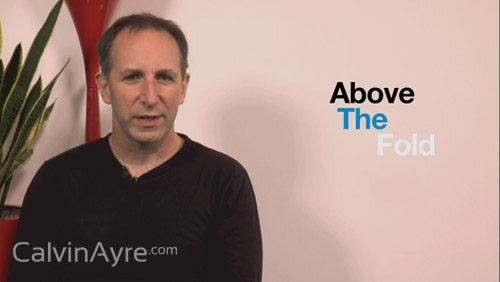90 Digital CEO Nick Garner talks about another important part of Trust Optimisation which is to make sure that users can trust that the content their about to see is Above the Fold in this episode of CalvinAyre.com’s SEO Tip of the Week.
Short intro to Trust Optimization.
Along with on site optimization and link acquisition, there seems to be a third element to ranking well on Google, it’s called Trust Optimization. Trust Optimization is based on the information we have got from anecdotal evidence on click through rates and rankings along with explicit guidelines from Google stating what they are looking for in a trusted website.
On with the post…
Trust is being confident you’re going to get the content you expect. If you click on a search result that suggests you’re going to see whatever it is, Google wants to make sure you get what you expect.
Google say in the 2014 quality rater guidelines:
“High quality pages are designed to achieve their purpose: they are well organized, use space effectively, and have a functional overall layout. While every page is different, functional pages should have the following characteristics:
• The MC should be prominently displayed “front and center.”
• The MC should be immediately visible when a user opens the page.
• It should be clear what the MC actually is. The page design, organization, and use of space, as well as the choice of font, font size, background, etc., should make the MC very clear.
• Ads and SC should be arranged so as not to distract from the MC—Ads and SC are there should the user want them, but they should be easily “ignorable” if the user is not interested.
• It should be clear what parts of the page are Ads, either by explicit labeling or simply by page organization or design.”
They care about ‘Main Content’
History
At one time a few years ago things were getting out of control – too many ads above the fold were upsetting users.
Then in January 2012 Google issued this statement.
“We’ve heard complaints from users that if they click on a result and it’s difficult to find the actual content, they aren’t happy with the experience. Rather than scrolling down the page past a slew of ads, users want to see content right away.
So sites that don’t have much content “above-the-fold” can be affected by this change. If you click on a website and the part of the website you see first either doesn’t have a lot of visible content above-the-fold or dedicates a large fraction of the site’s initial screen real estate to ads, that’s not a very good user experience. Such sites may not rank as highly going forward.”
And again in Oct 2014. Most recently, in Feb 2014 came another ‘top heavy’ update. Ref http://searchengineland.com/google-updates-page-layout-algorithm-go-sites-top-heavy-ads-183929
Imagine looking at a user on Google. They type in a search phrase look around on the results, click and dive into a page. The first thing they should see is the main content of that page.
It’s all sounds pretty simple, doesn’t it? But how often have you seen a complete train wreck of a page where the main content is obscured by bad site design or too many ads.
Here’s a diagram showing the area above the fold for a typical website. This diagram just accounts for desktop, Mobile is a whole other dimension to this.
You can see how little real estate there is for getting the main content delivered to a user.
Recapping
Main content is sacred territory for google. As you see, there is a mature algorithm geared up for weeding out pages which obscure main content.
When you apply this to Trust Optimization, for Google it’s really important users get what they expect. If you get in the way of this mission they will clear you out of their rankings.
Nick Garner is founder of 90 Digital, the well-known and respected iGaming search marketing agency.
Nick is obsessed with SEO and whatever it takes to rank sustainably on Google.

